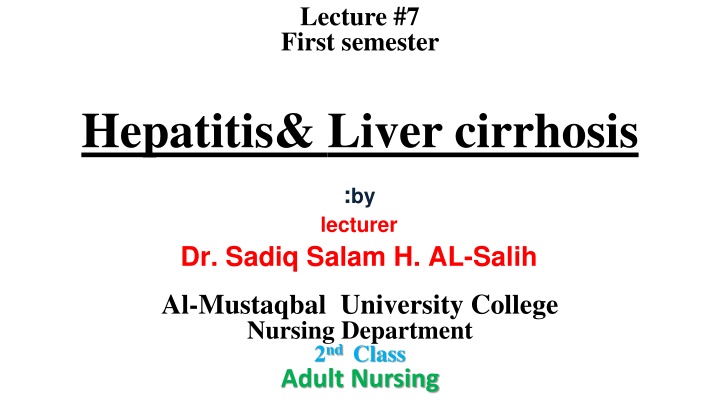
Understanding Hepatic Disorders and Liver Function
Explore the assessment and management of patients with hepatic disorders, focusing on liver functions like digestion, metabolism, and detoxification. Learn about laboratory tests for liver and pancreatic function, essential for diagnosing conditions such as hepatitis and liver cirrhosis.
Uploaded on | 0 Views
Download Presentation

Please find below an Image/Link to download the presentation.
The content on the website is provided AS IS for your information and personal use only. It may not be sold, licensed, or shared on other websites without obtaining consent from the author. If you encounter any issues during the download, it is possible that the publisher has removed the file from their server.
You are allowed to download the files provided on this website for personal or commercial use, subject to the condition that they are used lawfully. All files are the property of their respective owners.
The content on the website is provided AS IS for your information and personal use only. It may not be sold, licensed, or shared on other websites without obtaining consent from the author.
E N D
Presentation Transcript
Lecture #7 First semester Hepatitis& Liver cirrhosis :by lecturer Dr. Sadiq Salam H. AL-Salih Al-Mustaqbal University College Nursing Department 2nd Class Adult Nursing
Assessment and Management of Patients with Hepatic Disorders Liver is the largest gland in the body, can be considered a chemical factory that manufactures, stores, alters, and excretes a large number of substances involved in metabolism. The liver is located behind the ribs in the right upper portion of the abdominal cavity The liver is especially important in the regulation of glucose and protein metabolism. The liver manufactures and secretes bile, which has a major role in the digestion and absorption of fat in the GI tract. It removes the waste products from the blood stream and secretes them into the bile. The bile produced by the liver is stored temporarily in the gall bladder until it is needed for digestion, at which time the gall bladder empties and bile enters the intestine.
Functions of the liver Function Digestion Actions Bile salts for digestion/emulsification of fats Processing and storage of fats, carbohydrates and proteins absorbed by the intestine and sent to the liver via the portal circulation Processing and storage of vitamins and minerals Vitamin B 12, A, D, E ,K Metabolism of glucocorticoids, mineralocorticoids and sex hormones Regulation of fat, carbohydrate and protein metabolism Glucose stored as glycogen Main source of body heat Endocrine Temporary storage of blood Synthesis of bilirubin from breakdown of RBCs Hematopoiesis in certain disease states Synthesis of blood clotting factors (fibrinogen, thrombin, prothrombin) synthesis of albumin, prealbumin, Hematologic Excretion of bile pigment Excretion of cholesterol via bile Urea synthesis as the final step in the excretion of ammonia (protein breakdown) Detoxification of drugs, poisons and other foreign substances Excretion
Laboratory Assessment of Liver and Pancreatic Function Lab test Significance Direct bilirubin Indirect bilirubin Serum amylase Increased with biliary obstruction Increased with destruction of RBCs Pancreatic digestive enzymes, increased with acinar cells are destroyed. This test also measures salivary amylase (enzyme which converts starches into sugar), so pancreatic isoamylase more accurate Pancreatic digestive enzyme, increased with acute pancreatitis By-product of protein metabolism. Reduced synthesis of urea from body stores of ammonia, elevations seen in severe hepatic failure/injury and lead to encephalopathy (central nervous system dysfunction resulting from liver disease)and coma Cellular enzymes are released from hypoxic or damaged cells. AST, ALT, and LDH are increased from damaged liver, heart, kidney and muscle cells. ALP is increased with biliary obstruction LDH 5 is an isoenzyme from the liver and striated muscle GGT is more specific to liver disease Serum lipase Ammonia Enzymes: AST: Aspartate Amino Transferase, formerly SGOT ALT: Alanine Amino Transferase, formerly SGPT LDH: Lactic Dehydrogenase ALPAlkaline Phosphate GGT: Gamma Glutamyl Transpeptide
Assessing People with Hepatic Disorders: Common Hepatic Manifestations: 1. Abdominal pain or discomfort. 2. Nausea& vomiting. 3. Anorexia. 4. Weight loss. 5. Fluid and electrolytes imbalance. 6. Jaundice: Appear when the liver cannot able to metabolize bilirubin. 7. Altered mental or neurological status (Encephalopathy). This symptom has been attributed to: increase level of ammonia and other protein by product in the blood because of the inability of the liver to metabolize them into urea. 8. Increased susceptibility to infection. This symptom has been attributed to: the decreased ability of the liver to perform phagocytes may result in increased susceptibility to infection. 9. Altered bleeding tendencies. This symptom has been attributed to: The liver becomes unable to manufacture clotting factors or clear fibrinolysins result in increase the risk for bleeding. 10. Fatty food intolerance manifested by pain on ingestion of fat. 11. Dark, tea-colored urine or clay colored stools. 12. Altered bowel habit.
Hepatitis: Hepatitis is inflammation of the liver caused by viral infection or exposure to toxic chemicals Clinical Manifestation of the Phases of Hepatitis: Preicteric It lasts 1-21 days Icteric Post Icteric It lasts 2-4 weeks It persist several months 1. Malaise. 2. Easy fatigability. 3. Hepatomegaly. 1. Anorexia. 2. Nausea, vomiting. 3. Right upper quadrant discomfort. 4. Decrease sense of taste and smell. 5. Malaise. 6. Headache. 7. Fever. 8. Arthralgias. 9. Urticaria, rash. 10.Hepatomegaly & tenderness of the liver. 11.Splenomegaly. 12.Weight loss. 1. Jaundice. 2. Pruritus due to accumulation of bile salts under skin. 3. Dark urine. 4. Bilirubinuria. 5. Light or clay colored stool. 6. Fatigue. 7. Continued hepatomegaly with tenderness. 8. Weight loss.
Characteristics of Viral Hepatitis Virus Name Incubation Period Mode of transmission Source of infection and spread of disease Contaminated food, milk, water and selfish; person's with sub clinical infections infected food handler, poor personal hygiene, poor sanitation. Contaminated needles, syringes, and blood products. Sexual activity with infected partners. Oral-oral contact. Tattoo / body piercing, bites. Occupational hazards for health care personnel, hemodialysis staff, chemotherapy nurses, operating room nurses, dentists, persons at risk needle sticks. Blood and blood products, needles and syringes. Sexual activity with infected partners. Increased with sexual transmitted disease. Chronic treatment with hemodialysis. Hepatitis A virus ( HAV) 15-50 days ( average 30 days) Fecal-oral route; poor sanitation, person to person contact. Waterborne; food borne. Percutaneous (parenteral)/ permucosal exposure to blood or blood products Sexual contact. Perinatal transmission Hepatitis B virus ( HBV) 28-160 days (average 70-80 days) Hepatitis C virus ( HCV) (non A non-B) Called post transfusion H. 15-160 days (average 50 days) Transfusion of blood and blood products Exposure to contaminated blood or blood products through equipment High risk sexual contact. Perinatal contact. Can cause infection only together with HBV. Rotes of transmission same as for HBV. HBV surface antigen necessary for replication. Same as HBV. 21-140 days (average 35days) HBV must precede HDV; Chronic carriers of HBV are always at risk. Hepatitis D virus ( HDV) Fecal-oral. Outbreaks associated with contaminated water supply in developing countries Contaminated water; poor sanitation Hepatitis E virus ( HEV) Similar to HAV 15-65days ( average 42 days)
Nursing Care for a Patient with Hepatitis: 2- Present illness: Fatigue. Weight loss. Weight changes. Digestive disturbance. Skin changes. Feeling of fullness in right upper quadrant. 3- Functional assessment: Diet,. Alcohol intake. Occupation. Exposure to toxins. Interpersonal relationship. A-) Nursing Assessment: Subjective Data: Important Health Information: 1. Past health history: Previous liver disease, hepatitis immunization. Hemophilia.(An inherited bleeding disease) Exposure to infected persons. Ingestion of contaminated food and water. Sexual promiscuity. Exposure to toxins. Exposure to contaminated needles. Recent travel. Exposure to Organ transplant recipient. new drug regimen.
Objective Data: Possible findings: Vital signs: tachypnea, low grade fever. Skin: Dryness, scratches, jaundice, bruises, angioedema. (Sever form of urticaria which involve skin, face, hands and genital organ) Eyes: Icteric sclera. Thorax: Spider angiomas. Abdomen: Distention, prominent veins, hepatomegaly, Splenomegaly. Activity-exercise: Fatigue, Arthralgias (pain in joints), myalgias. Hypertension, Abnormal liver enzyme studies. Elevated serum bilirubin. Hypoalbuminemia. Anemia. Bilirubin in urine and increased urobilinogen. Prolonged prothrombin time. Serologic test positive for hepatitis, including anti-HAV IgM, anti-HBc IgM, anti-HCV, anti-HDV. Abnormal liver scan. Positive liver biopsy.
Management 1.Rest according to patient's level of fatigue. 2.Therapeutic measures to control dyspeptic symptoms and malaise. 3.Hospitalization for protracted nausea and vomiting or life-threatening complications. 4.Small, frequent feedings of a high-caloric, low fat diet; proteins are restricted when the liver cannot metabolize protein by-products, as demonstrated by the symptoms. 5.Vitamin K injected subcutaneously if prothrombin time is prolonged. 6.Intravenous fluid and electrolyte replacement as indicated. 7.Administration of antiemetic for nausea. 8.After jaundice has cleared gradual increase in physical activity. This may require many months. For HCV Patients: Long-term interferon (Betaseron) therapy may produce at least temporary remission. Complications: 1.Dehydration, Hypokalemia. 2.Chronic "carrier" hepatitis or chronic active hepatitis. 3.Diminution reduction or arrest of flow of bile. 4.Fulminant hepatitis (sudden, sever onset of acute liver failure that occurs within 8 weeks of the first symptoms of jaundice. 5.HBV carriers have a higher risk of developing Hepatocellular carcinoma. All types of hepatitis:
Measures to Prevent Transmission of Hepatitis Viruses From Patients to health Care Personnel: Hepatitis A Hepatitis B Hepatitis C Always maintain good personal hygiene. Wash hands after contact with a patient or removal of gloves. Use infection control precautions. Use infection control precautions. Wash hands. Reduce contact with blood or blood-containing secretions. Handle the blood of patients as potentially infective. Dispose of needles properly. Administer HBV vaccine to all health care personnel. Use needles IV access devices when available. Use infection control precaution. Wash hands. Reduce contact with blood or blood contaminated secretions. Handle the blood of patient as potentially infective. Dispose needles properly. Use needlesless IV access devices when available.
Nursing Diagnosis Altered Nutrition: Less Than Body Requirements related to anorexia and altered metabolism of nutrient by the liver as manifested by inadequate food intake , aversion to eating . Goals Maintaining Adequate Nutrition Nursing Intervention 1.Assess patient s appetite and adequacy of intake. 2.Provide oral care before meals to enhance patient dietary intake 3.Encourage frequent small feedings of high-calorie, low-fat diet. Avoid large quantities of protein during acute phase of illness . 4.Allow patient to choose food items ; serve high-carbohydrate and high protein foods at time of day patient feels most like eating to increase likllihood of adequate intake 5.Encourage eating meals in a sitting position to decrease pressure on the liver . 6.Encourage pleasing meals in an environment with minimal noxious stimuli (odors, noise, interruptions .( 7.Take weight daily in on same scale , at same time, with same clothes to monitor weight loss secondary to poor appetite. 8.Administer or teach self-administration of antiemetics as prescribed. Avoid phenothiazines, such as chlorpromazine (Thorazine), which have a cholestatic effect and may cause or worsen jaundice Fluid Volume Deficit related to nausea and/or vomiting Maintaining Adequate Fluid
Liver cirrhosis Cirrhosis is a chronic progressive disease of the liver. It is characterized by degeneration and destruction of liver cells. The effect of liver disease includes: Metabolic disturbances. Blood abnormalities. Fluid and electrolytes imbalances. Decreases of drugs and toxins. Obstruction of blood vessels and bile duct in of the liver. Incidence People between 40 and 60 years. It is more common in men than in women. It may be related to excessive alcohol intake.
Types of cirrhosis: Lannec's Cirrhosis caused by: Nutritional deficiencies. Exposure to alcohol. Exposure to toxins. The liver enlarges (knobby) then shrinking. It can be reversed if the case is corrected early. Post necrotic Cirrhosis: It is a complication of hepatitis, there is massive liver cell necrosis. Biliary Cirrhosis It is also called obstructive or idiopathic cirrhosis. It develops as a result of obstruction to bile flow. Cardiac Cirrhosis: It follows sever right side heart failure. Venous congestion and hypoxia leads to necrosis of the liver cells.
Signs and Symptoms: II-Progress of Disease: I. Mild Symptoms 1. GIT disturbances; anorexia, vomiting, diarrhea or constipation, flatulence and dyspepsia (heart burn). This is due to impaired of carbohydrate, fat, and protein metabolism. 2. Bulged dilate veins in the esophagus is called esophageal varices and in the rectum is called hemorrhoids. 3. Visible prominent veins in the abdomen. 4. Hematological disorders in the form of: a)Anemia, Leucko-cytopenia , Thrombocytopenia caused: Splenomegaly which result from back up of blood from the portal vein into the spleen. Over activity of the enlarged spleen result in increased removal of blood cells from circulation. Inadequate red blood cells production and survival. Poor diet, poor absorption of folic acid and bleeding from varices. b) Coagulation problems result from the liver's inability to produce Prothrombin and other factors essential for blood clot. The patient becomes easily tired and more liable to get infection. They may bleed extensively from minor trauma as epistaxis. 1. Slight weight loss. 2. Unexplained fever. 3. Fatigue. 4. Abdominal pain described as heavy feeling in the right upper quadrant or epigastruim due to: stretching of the liver capsule , spasm of the Biliary ducts, and intermittent vascular spasm 5. Dull hearing in the right upper abdomen on percussion. 6. Liver is palpable below the right rib margin.
III-Late Signs and Symptoms: 1. Jaundice with increase level. Result from a) The functional derangement of the liver cells b) Compression of bile ducts by connective tissues overgrowth and c) Decreased ability to conjugate and execrate bilirubin ( hepatocellular jaundice) 2. Pruritus due to accumulation f bile salts under the skin. 3. Congestion of the circulation in the intestines, stomach, esophagus. Increase pressure in veins in GIT cause dilate, bulge veins. 4. Skin Lesions: a) Spider angiomas or spider nevi: are small dilated blood vessels with a bright-red center point and spider-like branches. They occur on the nose, cheeks, upper trunk, neck and shoulders. b) Palmer erthymea: a red area that branches with pressure. 5. Signs and symptoms of hormonal excess: In men; gynecomastia (enlargement of the male mammary glands) impotence, testicular atrophy. In women; amenorrhea. 6. Water retention due to aldoesterone hormone excess (An adrenocortical steroid which by renal control, regulate electrolyte metabolism). 7. Confusion and disturbance as in conscious level due to accumulation of ammonia which affect CNS. 8. Ascites (accumulation of fluids in the peritoneal cavity). 9. Peripheral neuropathy (tingling or numbness in the extremities due to vit B12 and folic acid deficiencies).
Complications: 4-Ascites: It is an accumulation of fluid in the peritoneal cavity. 5-Hepatic Encephalopathy: (Hepatic Coma): Inability of the liver to toxify ammonia which causes: Accumulation of ammonia in the blood.( Treated by frequent enema) Neurologic symptoms include: 6- Hepatorenal syndrome: It is renal failure to the cirrhotic patient with advanced azotemia, oliguria. It follows: Diuretic therapy. Paracentesis GI Hemorrhage. 1- Portal Hypertension: The diseased liver changes obstruct the flow of incoming blood to back up in the portal system. It causes collateral vessels to develop (in an attempt to reduce this high pressure, reduce plasma volume and lymphatic flow) in the esophagus, anterior abdominal wall, and rectum. 2- Esophageal Varices: They are distended, engorged tortuous vessels in the esophagus. They are fragile and bleed easily. 3- Peripheral Edema: Result from decreased colloidal osmotic pressure from impaired liver synthesis of albumin and increased portocaval pressure from portal hypertension
Management 1. To limit deterioration of liver function. 2. To prevent complications. 3. To promote rest for liver regeneration. I. Drug Therapy: II. Collaborative Care: a) Bed rest. Is significant in reducing metabolic demands of the liver and allowing for recovery of liver cells. b) Diet characteristics must be: High in carbohydrate, vitamins. Moderate to high protein if ammonia level is normal. Restricted protein if ammonia level is high. Small frequent semisolid liquid meals to prevent anorexia. Give supplement iron and vitamins. Intravenous fluid to correct fluid and electrolyte imbalance. Restrict water and sodium in case of fluid retention. Anemia may require blood transfusion. c) Ascities: Administer albumin to: Maintain blood volume. Increase urinary out put If it is not respond with drugs fluid can be removed by Paracentesis: Paracentesis:It is the removal of ascetic fluid from the peritoneal cavity. Goals
















